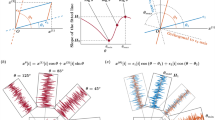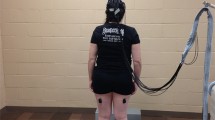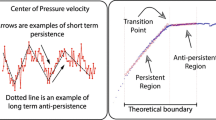Abstract
Aging is known to have a degrading influence on many structures and functions of the human sensorimotor system. The present work assessed aging-related changes in postural sway using fractal and complexity measures of the center of pressure (COP) dynamics with the hypothesis that complexity and fractality decreases in the older individuals. Older subjects (68 ± 4 years) and young adult subjects (28 ± 7 years) performed a quiet stance task (60 s) and a prolonged standing task (30 min) where subjects were allowed to move freely. Long-range correlations (fractality) of the data were estimated by the detrended fluctuation analysis (DFA); changes in entropy were estimated by the multi-scale entropy (MSE) measure. The DFA results showed that the fractal dimension was lower for the older subjects in comparison to the young adults but the fractal dimensions of both groups were not different from a 1/f noise, for time intervals between 10 and 600 s. The MSE analysis performed with the typically applied adjustment to the criterion distance showed a higher degree of complexity in the older subjects, which is inconsistent with the hypothesis that complexity in the human physiological system decreases with aging. The same MSE analysis performed without adjustment showed no differences between the groups. Taken all results together, the decrease in total postural sway and long-range correlations in older individuals are signs of an adaptation process reflecting the diminishing ability to generate adequate responses on a longer time scale.







Similar content being viewed by others
References
Bridger RS (1991) Some fundamental aspects of posture related to ergonomics. Int J Ind Ergon 8:3–15
Cabrera JL, Milton JG (2004) Human stick balancing: tuning Levy flights to improve balance control. Chaos 14:691–698
Collins JJ, De Luca CJ (1993) Open-loop and closed-loop control of posture: a random-walk analysis of center-of-pressure trajectories. Exp Brain Res 95:308–318
Costa M, Goldberger AL, Peng CK (2002) Multiscale entropy analysis of complex physiologic time series. Phys Rev Lett 89:068102
Costa M, Goldberger AL, Peng CK (2005) Multiscale entropy analysis of biological signals. Phys Rev E Stat Nonlin Soft Matter Phys 71:021906
Costa M, Priplata AA, Lipsitz LA, Wu Z, Huang NE, Goldberger AL, Peng CK (2007) Noise and poise: enhancement of postural complexity in the elderly with a stochastic-resonance-based therapy. Europhys Lett 77:68008
Dijkstra TMH (2000) A gentle introduction to the dynamic set-point model of human postural control during perturbed stance. Hum Mov Sci 19:567–595
Duarte M, Zatsiorsky VM (1999) Patterns of center of pressure migration during prolonged unconstrained standing. Motor Control 3:12–27
Duarte M, Zatsiorsky VM (2000) On the fractal properties of natural human standing. Neurosci Lett 283:173–176
Duarte M, Zatsiorsky VM (2001) Long-range correlations in human standing. Phys Lett A 283:124–128
Duarte M, Harvey W, Zatsiorsky VM (2000) Stabilographic analysis of unconstrained standing. Ergonomics 43:1824–1839
Feder J (1988) Fractals. Plenum Press, New York
Freitas SM, Wieczorek SA, Marchetti PH, Duarte M (2005) Age-related changes in human postural control of prolonged standing. Gait Posture 22:322–330
Gell-Mann M (1995) What is complexity? Complexity 1:16–19
Goldberger AL, Amaral LA, Hausdorff JM, Ivanov P, Peng CK, Stanley HE (2002a) Fractal dynamics in physiology: alterations with disease and aging. Proc Natl Acad Sci USA 99(Suppl 1):2466–2472
Goldberger AL, Peng CK, Lipsitz LA (2002b) What is physiologic complexity and how does it change with aging and disease? Neurobiol Aging 23:23–26
Havlin S, Blumberg Selinger R, Schwartz M, Stanley HE, Bunde A (1988) Random multiplicative processes and transport in structures with correlated spatial disorder. Phys Rev Lett 61:1438–1441
Horak FB, Shupert CL, Mirka A (1989) Components of postural dyscontrol in the elderly: a review. Neurobiol Aging 10:727–738
Lipsitz LA (2002) Dynamics of stability: the physiologic basis of functional health and frailty. J Gerontol A Biol Sci Med Sci 57:B115–B125
Lipsitz LA (2004) Physiological complexity, aging, and the path to frailty. Sci Aging Knowl Environ 2004:pe16
Lipsitz LA, Goldberger AL (1992) Loss of ‘complexity’ and aging. Potential applications of fractals and chaos theory to senescence. JAMA 267:1806–1809
Maurer C, Peterka RJ (2005) A new interpretation of spontaneous sway measures based on a simple model of human postural control. J Neurophysiol 93:189–200
Peng CK, Havlin S, Stanley HE, Goldberger AL (1995) Quantification of scaling exponents and crossover phenomena in nonstationary heartbeat time series. Chaos 5:82–87
Pincus SM (1991) Approximate entropy as a measure of system complexity. Proc Natl Acad Sci USA 88:2297–2301
Richman JS, Moorman JR (2000) Physiological time-series analysis using approximate entropy and sample entropy. Am J Physiol Heart Circ Physiol 278:H2039–H2049
Roerdink M, De Haart M, Daffertshofer A, Donker SF, Geurts AC, Beek PJ (2006) Dynamical structure of center-of-pressure trajectories in patients recovering from stroke. Exp Brain Res 174:256–269
Theiler J, Eubank S, Longtin A, Galdrikian B, Farmer DJ (1992) Testing for nonlinearity in time series: the method of surrogate data. Phys D Nonlinear Phenom 58:77–94
Thurner S, Mittermaier C, Ehrenberger K (2002) Change of complexity patterns in human posture during aging. Audiol Neurootol 7:240–248
Vaillancourt DE, Newell KM (2002) Changing complexity in human behavior and physiology through aging and disease. Neurobiol Aging 23:1–11
Vaillancourt DE, Sosnoff JJ, Newell KM (2004) Age-related changes in complexity depend on task dynamics. J Appl Physiol 97:454–455
Whistance RS, Adams LP, van Geems BA, Bridger RS (1995) Postural adaptations to workbench modifications in standing workers. Ergonomics 38:2485–2503
Zatsiorsky VM, Duarte M (1999) Instant equilibrium point and its migration in standing tasks: rambling and trembling components of the stabilogram. Motor Control 3:28–38
Acknowledgments
This work was made possible by a grant from Fundação de Amparo à Pesquisa do Estado de São Paulo, FAPESP/Brazil awarded to Marcos Duarte (04/10917-0). Dagmar Sternad was supported by grants from the National Science Foundation (BCS-0450218) and the National Institutes of Health (RO1-HD045639).
Author information
Authors and Affiliations
Corresponding author
Rights and permissions
About this article
Cite this article
Duarte, M., Sternad, D. Complexity of human postural control in young and older adults during prolonged standing. Exp Brain Res 191, 265–276 (2008). https://doi.org/10.1007/s00221-008-1521-7
Received:
Accepted:
Published:
Issue Date:
DOI: https://doi.org/10.1007/s00221-008-1521-7




